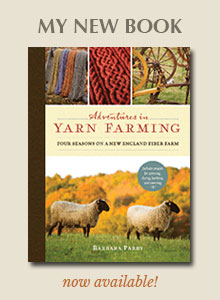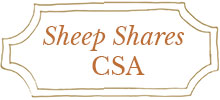I thought I'd use today's post to address two questions I've been asked recently:
Q: How are Mistral & Georgia doing?
A: Happy as clams. Or maybe I should say as happy as lambs. Mistral, Georgia and friends are wintering in the Open Barn. The group has quickly bonded with Sol, our new llama. Feeding is the highlight of their day. As far as I can tell, they spend the rest of their time lounging in the yard with Sol, unless the weather stinks. Then they lounge around the barn. The ewe lambs we have kept from 2010 lambing are super people-focused. It's one of the easiest groups to work with. We're looking forward to shearing their fleeces on March 25.
Q: Why do our sheep wear coats?
A: It's the question I'm asked most frequently. I gave a presentation Adventures in Yarn Farming to a weaving guild last Saturday and this question was at the top of the list.
Sheep seem to enjoy wearing their food almost as much as eating it. Just look at the photos. The lambs have a special talent for dredging themselves in hay and chaff. It covers every square inch of wool not covered by their jacket. It's exactly the way toddlers eat (I'm looking at a photo of my neice, 18 months old, sitting in her high chair with her face plastered with Spaghettios – same thing).
As a fiber producer I have to look at every possible way to protect the wool. There is no way that fiber processing can remove the crap that lodges in fleece from winter feeding. Large commercial operations employ a process called carbonization – where wool is soaked in an acid bath (either sufuric or hydrochloric acid) to disintegrate burrs, seeds, hay chaff and any other organic matter in wool. The process is harsh and can actually damage the fibers. It can also make wool feel scratchy.
To the best of my knowledge, none of the fiber mills used by fiber farmers use this process. If you buy yarn or roving from a shepherd who has raised the wool, the wool has not been carbonized. Small and medium mills use a scouring process that involves many gallons of hot water and a scouring agent (such as Eco-scour), to loosen debris and release the lanolin (natural sheep grease) from wool. The task is time consuming and wonderfully odiferous (ask me how I know :^). There are no short cuts. A sticky fleece really gums up the carding equipment, so processors must be super picky that only clean wool hits the carder.
Scouring does not remove VM from wool. Some mills use a machine called a tumbler to shake plant particles from fleece post washing. I saw one in action a few years ago at Stonehedge Fiber Mill. The shake-out works better on loose-locked longwool varieties than on fine wool fleeces. Some vm comes out in the process of picking the wool (the stage of opening up the clean fibers before carding).Once the wool hits the carder, whatever crap is in the wool stays there. In fact, it gets rather nicely distributed throughout the carded fleece. So one tiny head of burdock that escapes detection in skirting and makes it through the scouring process explodes on the carding machine and gets nicely blended into the yarn. Trust me, it's an undesirable design feature.
So sheep coats are our first line of defense for producing high quality fleece. IMO worth the expense and work.
As you can see from the photos, there's a heart-breaking amount of wool on these girls that's unusable for yarn product, even though there is nothing wrong with the wool itself. We use some of it for batting and crafting, and the balance as mulch. Sigh.




